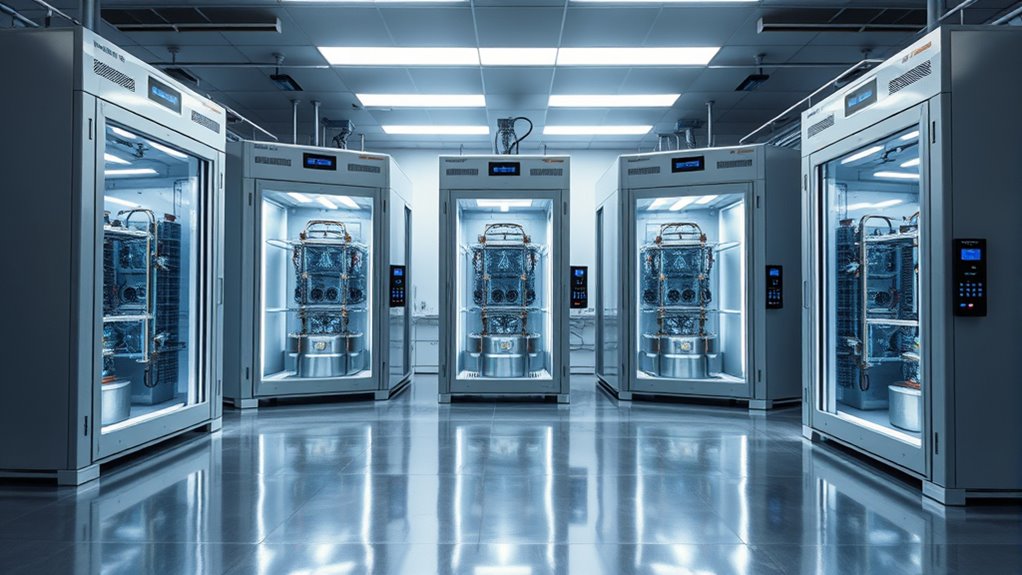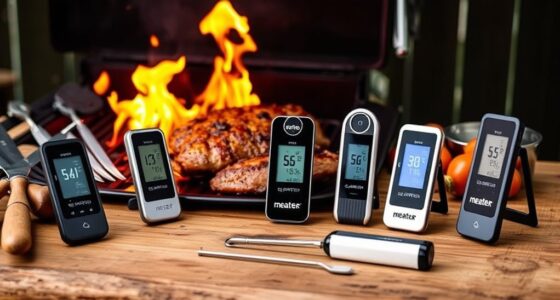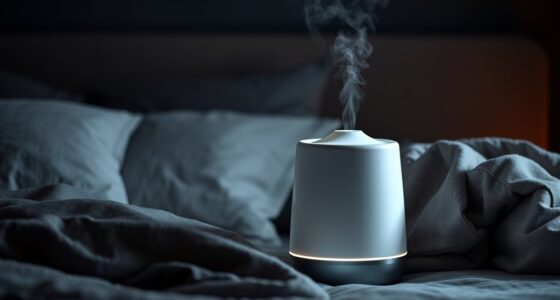I’ve reviewed several top climatic chambers ideal for materials testing in 2025. My picks focus on units that offer precise temperature and humidity control, broad environmental ranges, and reliable uniformity for accurate results. These chambers are suited for simulating extreme conditions, ensuring your tests are consistent and dependable. If you keep exploring, I’ll guide you through the features that make these chambers stand out and help you choose the best fit for your needs.
Key Takeaways
- Top-rated climatic chambers feature precise temperature and humidity controls for reliable materials testing in 2025.
- Reviews highlight chambers with fast stabilization times, adjustable parameters, and uniform environmental conditions.
- Leading models offer advanced data logging, remote monitoring, and user-friendly interfaces for efficient testing.
- Considerations include chamber size, compatibility with testing standards, and ease of maintenance.
- Expert picks emphasize durability, energy efficiency, and customizable profiles for diverse materials testing needs.
3 ROOM Mold Test Kit with BioVac™ Air Sampler and Full Analysis
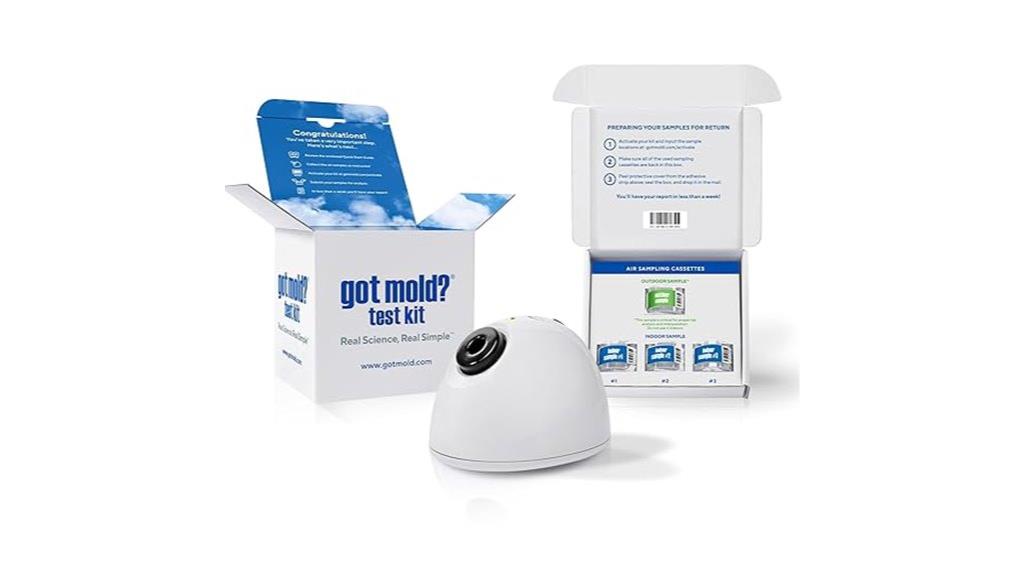
If you’re a homeowner, tenant, or property manager seeking a straightforward way to detect mold, the ROOM Mold Test Kit with BioVac™ Air Sampler is an excellent choice. It offers professional-quality testing in a simple, user-friendly package. The kit includes a reusable BioVac™ Air Sampler, air sampling cassettes, and prepaid return shipping. In about five minutes per room, you can collect airborne mold particles, then send samples to the lab for detailed analysis. Results arrive within a week, highlighting mold types and quantities with clear, color-coded reports. Many users find it convenient, easy to operate, and a valuable first step in evaluating mold risks.
Best For: homeowners, tenants, and property managers seeking a quick, easy, and cost-effective DIY mold detection method.
Pros:
- Easy to use with simple, quick sampling process (about 5 minutes per room)
- Reusable BioVac™ Air Sampler with cassette refills for ongoing testing
- Detailed, professional-quality lab reports with mold types, quantities, and clear guidance
Cons:
- Air testing may produce false negatives or underestimate mold levels
- Less accurate than professional on-site inspections, especially for hidden mold issues
- Results can be influenced by environmental factors, requiring supplementary assessments for comprehensive evaluation
Air Quality Monitor Indoor with WiFi and E-Ink Display
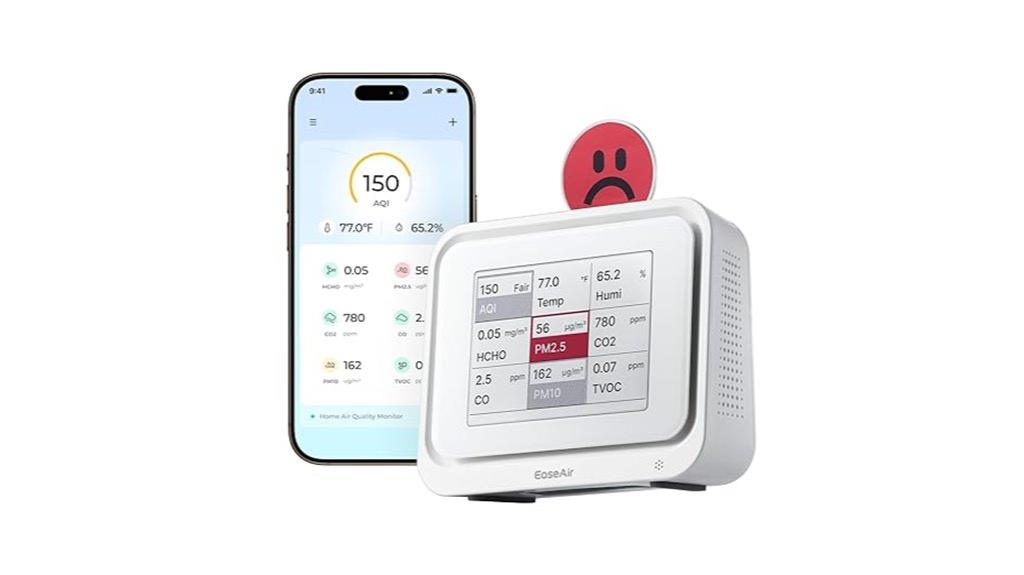
The Air Quality Monitor Indoor with WiFi and E-Ink Display is an excellent choice for homeowners and allergy sufferers who want easy, real-time insight into their indoor air quality. It measures CO2, CO, PM2.5, PM10, formaldehyde, TVOC, humidity, and temperature, providing extensive data with color-coded emoji indicators. The device features a 4.2-inch E-Ink screen, WiFi connectivity for remote monitoring, and up to 30 days of battery life. Although the screen isn’t backlit and can be glitchy, the companion app offers stable remote control and data access. Its portability makes it ideal for small spaces, helping users manage air quality proactively.
Best For: homeowners, allergy sufferers, and pet owners seeking easy, real-time indoor air quality monitoring with portable, comprehensive data.
Pros:
- Provides extensive measurements including CO2, CO, PM2.5, PM10, formaldehyde, TVOC, humidity, and temperature for thorough air assessment
- Portable design with up to 30 days battery life, ideal for small spaces and on-the-go monitoring
- WiFi connectivity and companion app enable remote access to real-time data and historical trends
Cons:
- Non-backlit, glitchy E-Ink screen limits usability in low-light environments and can affect readability
- CO2 sensor readings tend to be high and may lack accurate calibration options, affecting measurement reliability
- Pairing issues with certain smartphones and networks can hinder seamless remote control and data access
Mold Test Kit for Home, Indoor Air Quality Detection, DIY Mold Detector, Includes Lab Analysis
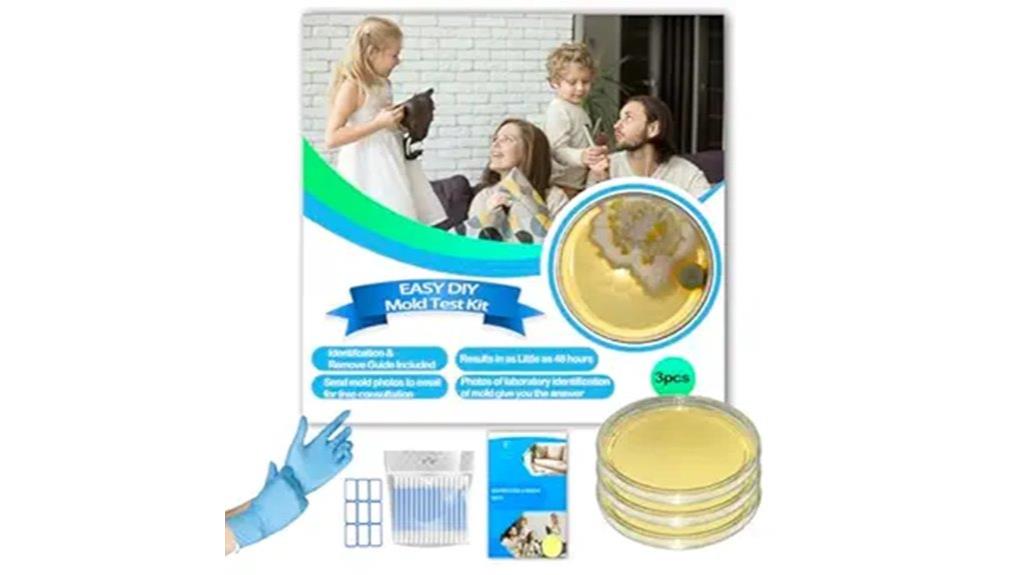
This DIY mold test kit is an excellent choice for homeowners and property managers seeking quick, cost-effective insights into indoor air quality. It includes three petri dishes, a detailed mold identification guide, and all necessary testing accessories, making it easy to sample surfaces, air, and HVAC systems without professional help. Results are available within 48 hours, and the kit supports multiple testing methods to cover different areas of your home. While it’s simple to use and provides valuable information, some limitations exist, such as potential airborne contamination and limited strain identification accuracy. Overall, it’s a practical tool for basic mold detection and indoor air quality assessment.
Best For: homeowners and property managers seeking a quick, affordable, and easy DIY solution for initial indoor mold and air quality testing.
Pros:
- Comprehensive kit includes all necessary sampling tools and detailed mold identification guide.
- Supports multiple testing methods for surfaces, air, and HVAC systems, providing versatile assessment options.
- Quick results within 48 hours help identify potential issues promptly.
Cons:
- Limited accuracy in identifying specific mold strains and potential for airborne contamination during testing.
- Some users report unclear instructions and issues with sample analysis services.
- Packaging quality and sample handling can sometimes be inconsistent, affecting reliability.
7-in-1 Indoor Air Quality Monitor with CO2, TVOC, HCHO Detection and Display
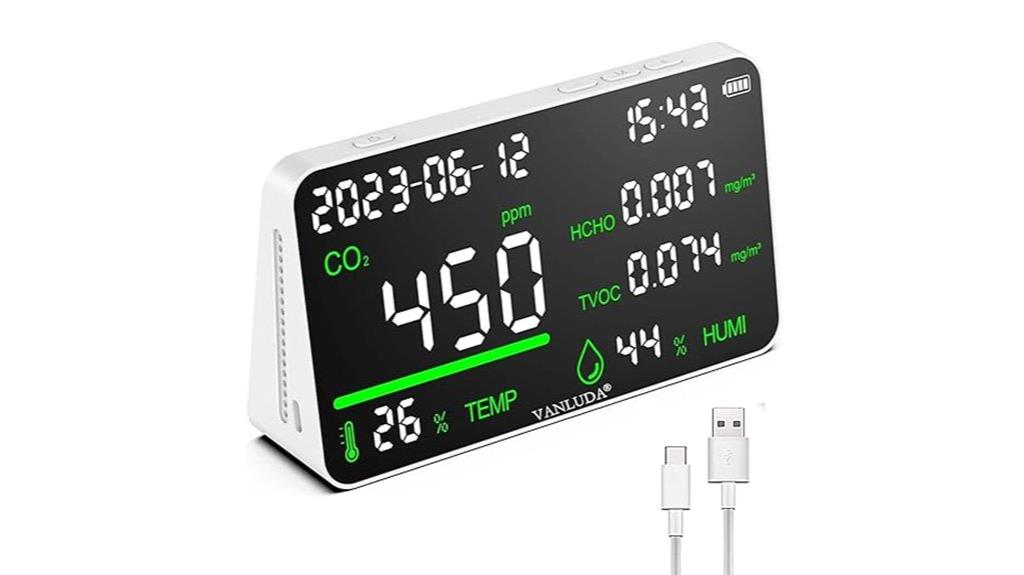
For anyone seeking a compact and easy-to-use indoor air quality monitor, the 7-in-1 device stands out as an ideal choice. It features a sleek desktop design with a large LCD screen that displays real-time measurements of CO2, TVOC, HCHO, temperature, humidity, and more. Its sensors deliver accurate data, with color-coded AQI warnings for quick assessment. The device offers continuous monitoring via USB power or rechargeable battery, lasting up to three days. Designed for simplicity, it provides immediate alerts and easy controls. Though some users note occasional inaccuracies or short battery life, overall, it’s a practical tool for maintaining healthy indoor environments.
Best For: individuals seeking a compact, easy-to-use indoor air quality monitor to ensure a safe and healthy environment at home, office, or classroom.
Pros:
- Provides real-time, comprehensive air quality data including CO2, TVOC, HCHO, temperature, and humidity with a user-friendly LCD display.
- Compact and sleek design suitable for desktop placement, with options for continuous power or rechargeable battery use.
- Features color-coded AQI warnings and alerts for quick assessment of air safety conditions.
Cons:
- Some users report occasional inaccuracies during wildfire smoke events and fluctuations in humidity readings.
- Short battery life, typically less than 23 hours, may require frequent recharging or constant power connection.
- Intermittent beeping alerts and certain device malfunctions can be bothersome or reduce reliability over time.
MEASUREMAN Pressure and Temperature Test Kit
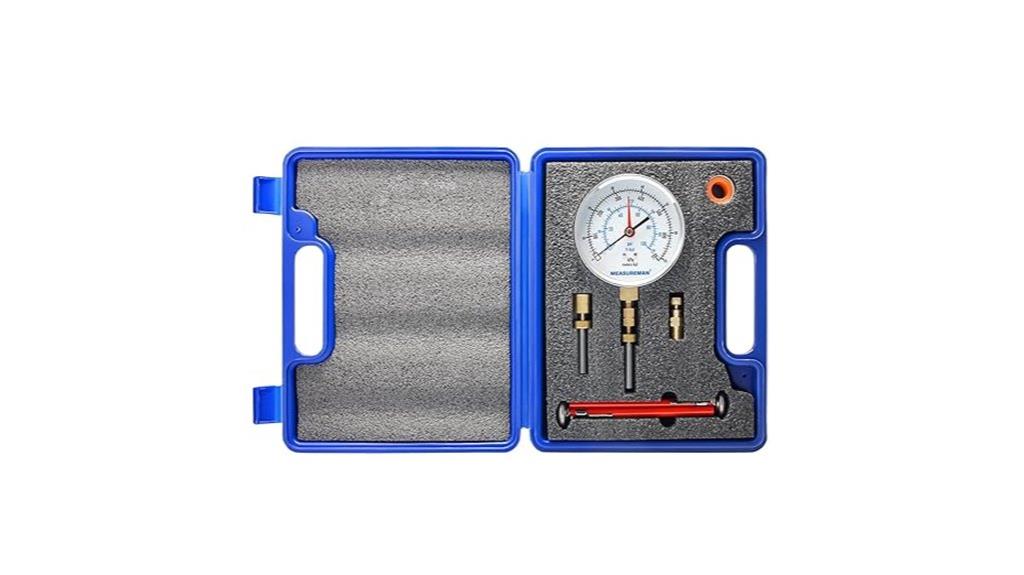
If you’re responsible for pipeline or vessel maintenance, the MEASUREMAN Pressure and Temperature Test Kit offers precise, reliable measurements that streamline your testing process. With a robust 4-inch dial and durable construction, it accurately measures pressure from 0-100 psi, kPa, or meters H2O, and temperatures from -40°F to 220°F. Its high-quality fittings ensure leak-free operation, and the kit includes essential adapters, thermometers, and a sturdy case for portability. Designed for start-up, maintenance, and testing across various systems—like refrigeration, hydronics, or natural gas—it provides quick, clear readings, making your work more efficient and dependable.
Best For: professionals involved in pipeline, vessel maintenance, and system testing requiring accurate pressure and temperature measurements across various engineering applications.
Pros:
- High accuracy and reliable readings with a clear 4-inch dial
- Durable construction with high-quality fittings to prevent leaks
- Versatile multi-scale options for quick measurement in different units
Cons:
- Slightly higher price point compared to similar basic gauges
- Requires careful handling to maintain calibration over time
- Bulkier size may be less suitable for tight or confined spaces
LifeSource Replacement Humidifier Water Chamber for Resvent iBreeze CPAP Machine
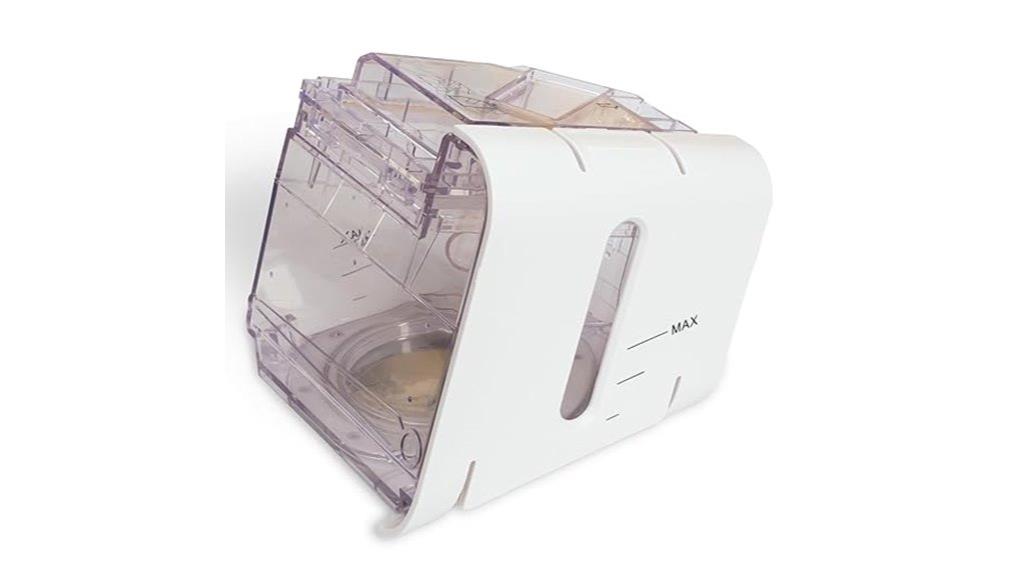
The LifeSource Replacement Humidifier Water Chamber is an excellent choice for users of the Resvent iBreeze CPAP machine seeking a reliable, high-quality replacement. It’s specifically designed for perfect compatibility, ensuring a snug fit without modifications. The transparent design makes water level monitoring easy, helping maintain ideal humidification. Installation is simple, and the durable materials make cleaning straightforward, promoting hygiene and longevity. This chamber holds more water than OEM parts, allowing for longer use between refills. Customers praise its performance, noting improved sleep quality and reliability. Overall, it’s a cost-effective upgrade that enhances the CPAP experience through consistent, comfortable humidification.
Best For: Users of the Resvent iBreeze CPAP machine seeking a durable, easy-to-maintain, and reliable replacement water chamber for enhanced humidification.
Pros:
- Designed specifically for perfect compatibility with the Resvent iBreeze CPAP, ensuring a snug, secure fit
- Transparent water chamber allows easy water level monitoring and maintenance
- Holds more water than OEM parts, providing longer use between refills and improved performance
Cons:
- May require initial familiarization with installation if unfamiliar with the design
- Slightly higher cost compared to generic or OEM parts, though offset by quality and capacity
- Limited to use with Resvent iBreeze CPAP machines; not compatible with other models
Factors to Consider When Choosing Climatic Chambers for Materials Testing
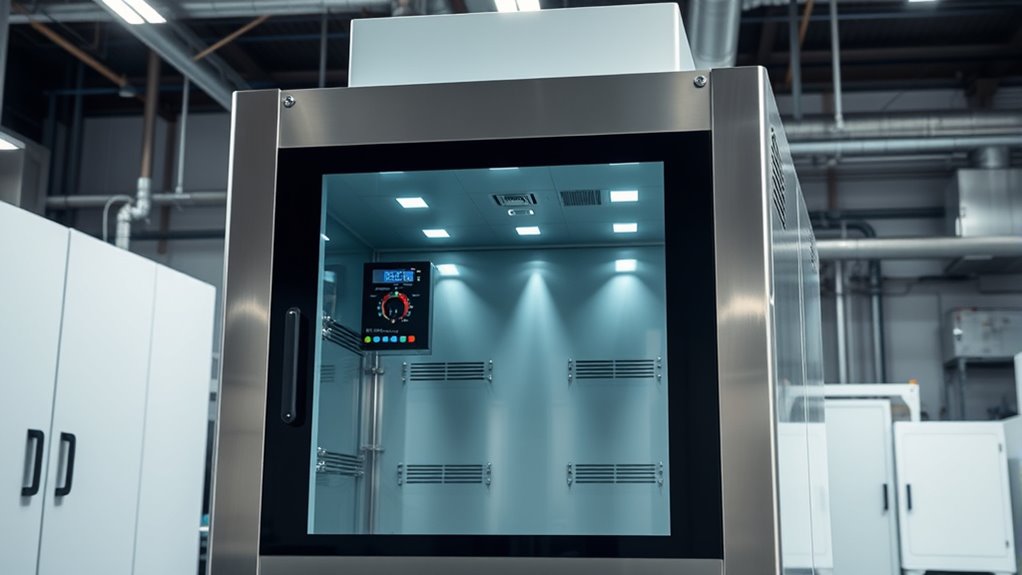
When selecting a climatic chamber, I focus on key factors like temperature range flexibility and humidity control precision to guarantee accurate testing conditions. I also consider the chamber’s testing volume capacity and how well it maintains environmental uniformity for consistent results. Finally, ease of operation plays a crucial role in making the testing process efficient and user-friendly.
Temperature Range Flexibility
Choosing a climatic chamber with the right temperature range flexibility is essential for accurate materials testing. It allows me to simulate diverse environmental conditions, from extreme cold to high heat, providing thorough performance data. I look for chambers that maintain temperature settings precisely, usually within ±0.5°C, ensuring reliable results. Quick temperature stabilization is also vital, as it shortens testing cycles and improves efficiency. Programmable temperature profiles are a bonus, enabling me to mimic real-world temperature fluctuations over time for more realistic testing scenarios. Finally, I verify that the chamber’s maximum and minimum temperature limits align with my specific testing needs. A broad temperature range and stable control give me confidence that I can thoroughly evaluate materials under varied environmental conditions.
Humidity Control Precision
How precisely a climatic chamber regulates humidity can make or break the reliability of your material tests. Maintaining relative humidity within ±1% to ±3% RH of the set point is essential for accurate results. High-accuracy chambers use advanced sensors, like chilled mirror or capacitive types, to guarantee stable, reliable humidity regulation. This is especially important for testing moisture-sensitive materials such as polymers, electronics, and biological samples. Achieving tight humidity tolerances often requires independent control systems for temperature and humidity, preventing fluctuations that could skew data. Consistent humidity control enhances test reproducibility and better simulates real-world conditions, providing confidence in your material’s durability and performance assessments. When selecting a climatic chamber, prioritize models with proven precision in humidity control.
Testing Volume Capacity
The size and capacity of a climatic chamber directly impact its suitability for different testing needs. If you’re testing whole assemblies or multiple samples simultaneously, you’ll need a larger chamber with ample internal space. Conversely, for individual material samples, a smaller chamber suffices. The chamber’s internal dimensions and airflow capacity are essential because they determine how well it maintains consistent temperature and humidity throughout the space. High-volume chambers often incorporate advanced circulation systems to ensure uniform conditions, which is critical for reliable results across all samples. When choosing a chamber, consider the size and quantity of your specimens to make certain the volume capacity aligns with your testing protocols. An appropriate capacity not only improves accuracy but also enhances efficiency during testing cycles.
Environmental Uniformity
Ensuring environmental uniformity within a climatic chamber is crucial for obtaining accurate and reproducible material testing results. Consistent temperature, humidity, and airflow throughout the chamber prevent localized variations that could skew data. Achieving high uniformity depends on advanced control systems, like precise circulation fans and evenly distributed heating or cooling elements. To verify uniform conditions, multiple sensors are strategically placed to measure environmental parameters across different zones. Regular calibration and validation are essential to maintain this uniformity, ensuring the chamber consistently meets specified standards. Variability in environmental conditions can lead to inconsistent material responses, compromising test reliability. Consequently, selecting a chamber with proven uniformity features is essential for ensuring trustworthy results in material testing.
Ease of Operation
When selecting a climatic chamber for materials testing, ease of operation plays a vital role in maximizing efficiency and accuracy. An intuitive interface with digital displays and simple menus makes adjusting temperature, humidity, and other parameters quick and straightforward. Automated features like programmable cycles and preset conditions minimize manual input, saving time and reducing errors. User-friendly maintenance, such as easy access to filters and sensors, helps guarantee consistent performance without complex procedures. Additionally, extensive documentation and clear safety instructions are essential, especially for operators with varying technical backgrounds. By prioritizing ease of operation, you guarantee smoother testing processes, quicker setup times, and fewer operational mistakes, ultimately leading to more reliable results and improved productivity.
Maintenance and Durability
Maintaining a climatic chamber’s performance over time requires careful attention to its construction quality and ongoing upkeep. Regularly cleaning humidity and temperature sensors ensures measurement accuracy and prevents malfunctions. The durability of the chamber depends heavily on the materials used, such as corrosion-resistant metals and high-grade plastics, which resist wear and environmental damage. Proper calibration and periodic servicing are essential for extending the lifespan and maintaining consistent testing conditions. Additionally, the chamber’s sealing integrity—door gaskets and access ports—must be maintained to prevent leaks, contamination, and fluctuations in environmental parameters. It’s also vital to consider the operating environment, including resistance to temperature swings and mechanical stress, to ensure the chamber remains reliable and durable over the long term.
Frequently Asked Questions
How Do Climatic Chambers Ensure Consistent Temperature and Humidity Control?
Climatic chambers keep temperature and humidity consistent by using precise sensors and advanced control systems. I’ve seen them automatically adjust heating, cooling, and moisture levels, maintaining stable conditions. They rely on feedback loops that constantly monitor the environment, ensuring everything stays within set ranges. This reliable regulation is essential for accurate testing, giving me confidence that material behavior is tested under true, controlled climate conditions.
What Safety Features Are Essential in Advanced Climatic Chambers?
Safety features are vital in advanced climatic chambers. I look for alarms that alert me to temperature or humidity deviations, ensuring immediate action. Over-temperature and over-humidity protections prevent equipment damage and safety hazards. Emergency stop buttons and door interlocks keep operators safe during malfunctions. Additionally, proper grounding and insulation minimize electrical risks. These features give me peace of mind, knowing the chamber operates safely even under challenging testing conditions.
Can Climatic Chambers Simulate Extreme Environmental Conditions Accurately?
Climatic chambers are like precise storytellers, accurately mimicking extreme environments. I’ve seen them replicate conditions such as scorching heat or freezing cold with remarkable accuracy, ensuring reliable test results. They control temperature, humidity, and other factors tightly, so you can trust their simulations. While no system is perfect, modern chambers are incredibly sophisticated, making them invaluable for testing materials under harsh conditions without leaving the lab.
What Is the Typical Lifespan of a High-Quality Climatic Chamber?
A high-quality climatic chamber typically lasts between 10 to 15 years, depending on usage and maintenance. I’ve seen well-maintained units operate reliably for over a decade, while neglect can shorten their lifespan. Regular calibration, proper cleaning, and timely repairs are key to extending their longevity. If you invest in a reputable brand and keep up with maintenance, you’ll get the most out of your chamber for many years to come.
How Do Maintenance Requirements Vary Among Different Climatic Chamber Models?
Think of climatic chambers as high-performance engines—they all need tune-ups, but requirements differ. Some models demand frequent filter changes and calibration, like a car needing regular oil changes, while others are more low-maintenance, like a well-oiled machine. I’ve seen that advanced chambers with precise controls often require less daily attention, but periodic checks are still essential. Proper maintenance depends on the chamber’s complexity and usage intensity.
Conclusion
In the end, choosing the right climatic chamber is about finding the perfect fit for your testing needs. Don’t put all your eggs in one basket—consider factors like temperature range, humidity control, and ease of use. Remember, the devil is in the details, so take your time and pick wisely. After all, a well-chosen chamber can make all the difference in ensuring your materials stand the test of time.
